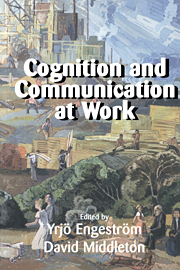Book contents
- Frontmatter
- Contents
- Contributors
- Acknowledgments
- 1 Introduction: Studying work as mindful practice
- 2 Distributed cognition in an airline cockpit
- 3 Constituting shared workspaces
- 4 Seeing as situated activity: Formulating planes
- 5 Convergent activities: Line control and passenger information on the London Underground
- 6 Users and designers in mutual activity: An analysis of cooperative activities in systems design
- 7 System disturbances as springboard for development of operators' expertise
- 8 Expert and novice differences in cognition and activity: A practical work activity
- 9 The tensions of judging: Handling cases of driving under the influence of alcohol in Finland and California
- 10 Talking work: Argument, common knowledge, and improvisation in teamwork
- 11 The collective construction of scientific genius
- 12 Experience and the collective nature of skill
- 13 Working together: Symbolic interactionism, activity theory, and information systems
- 14 On the ethnography of cooperative work
- Index
6 - Users and designers in mutual activity: An analysis of cooperative activities in systems design
Published online by Cambridge University Press: 05 June 2012
- Frontmatter
- Contents
- Contributors
- Acknowledgments
- 1 Introduction: Studying work as mindful practice
- 2 Distributed cognition in an airline cockpit
- 3 Constituting shared workspaces
- 4 Seeing as situated activity: Formulating planes
- 5 Convergent activities: Line control and passenger information on the London Underground
- 6 Users and designers in mutual activity: An analysis of cooperative activities in systems design
- 7 System disturbances as springboard for development of operators' expertise
- 8 Expert and novice differences in cognition and activity: A practical work activity
- 9 The tensions of judging: Handling cases of driving under the influence of alcohol in Finland and California
- 10 Talking work: Argument, common knowledge, and improvisation in teamwork
- 11 The collective construction of scientific genius
- 12 Experience and the collective nature of skill
- 13 Working together: Symbolic interactionism, activity theory, and information systems
- 14 On the ethnography of cooperative work
- Index
Summary
We are proposing and analyzing a cooperative prototyping approach wherein users are involved actively and creatively in design of computer applications. What we are suggesting is use of early prototypes in attempts to create and explore new work activities for the involved users. This chapter illustrates the approach by analyzing the design of computer support for casework in a technical department of a Danish municipality. Prototyping, as a design activity, is viewed as an ongoing learning process, and we analyze situations where openings for learning occur in the prototyping activity. Users and designers engage in this design activity, based on their different practices, and the development of the use activity is the primary focus of design. The situations that we are analyzing seem to fall into four categories:
Situations where the future work situation with a new computer application is simulated to investigate the future work activity.
Situations where the prototype is manipulated and used as a basis for idea exploration.
Situations focussing on the designers' learning about the users' work practice.
Situations where the prototyping tool or the design activity as such becomes the focus.
Lessons learned from the analysis of these situations are discussed. In particular, we discuss a tension between the need for careful preparation of prototyping activity and the need to establish conditions for user and designer creativity. Our approach to understanding these prototyping situations is inspired by activity theory, in particular the work of Engeström, wherein learning is seen as an expansion of work practice.
- Type
- Chapter
- Information
- Cognition and Communication at Work , pp. 130 - 158Publisher: Cambridge University PressPrint publication year: 1996
- 20
- Cited by



